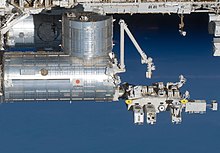 The Japanese Experiment Module, EFU 3 is the occupied location second from the left. | |
| Operator | NASA |
|---|---|
| Manufacturer | Jet Propulsion Laboratory[1] |
| Instrument type | Grating spectrometer |
| Function | Atmospheric CO2 and SIF |
| Mission duration | 10 years (nominal) Elapsed: 5 years, 5 months, 2 days |
| Website | www |
| Properties | |
| Mass | 500 kg (1,100 lb)[2] |
| Dimensions | 1.85 × 1.0 × 0.8 m (6.1 × 3.3 × 2.6 ft) |
| Power consumption | 600 W |
| Resolution | Less than 4 km2 (1.5 sq mi) |
| Spectral band | 2.06 microns 1.61 microns 0.765 microns[3] |
| Data rate | 8 footprints, 3 Hz (24 per second) |
| Host spacecraft | |
| Spacecraft | International Space Station |
| Launch date | 4 May 2019, 06:48 UTC |
| Rocket | Falcon 9 |
| Launch site | Cape Canaveral, SLC-40 |
The Orbiting Carbon Observatory-3 (OCO-3) is a NASA-JPL instrument designed to measure carbon dioxide in Earth's atmosphere. The instrument is mounted on the Japanese Experiment Module-Exposed Facility on board the International Space Station (ISS).[4] OCO-3 was scheduled to be transported to space by a SpaceX Dragon from a Falcon 9 rocket on 30 April 2019,[5] but the launch was delayed to 3 May, due to problems with the space station's electrical power system.[6] This launch was further delayed to 4 May due to electrical issues aboard Of Course I Still Love You (OCISLY), the barge used to recover the Falcon 9’s first stage.[7] OCO-3 was launched as part of CRS-17 on 4 May 2019 at 06:48 UTC.[8] The nominal mission lifetime is ten years.[3]
OCO-3 was assembled using spare materials from the Orbiting Carbon Observatory-2 satellite.[4] Because the OCO-3 instrument is similar to the OCO-2 instrument, it is expected to have similar performance with its measurements used to quantify CO2 to 1 ppm precision or better at 3 Hz.[9]
- ^ "NASA.gov" (PDF). Archived from the original (PDF) on 2019-04-05. Retrieved 2019-04-05.
- ^ Eldering, Annmarie (2013). The OCO-3 Mission: An Overview (PDF). 9th International Workshop on Greenhouse Gas Measurements from Space. 29–31 May 2013. Yokohama, Japan.
- ^ a b Eldering, Annmarie; Taylor, Tommy E.; O'Dell, Chris W.; Pavlick, Ryan (2018). "The OCO-3 mission; measurement objectives and expected performance based on one year of simulated data". Atmospheric Measurement Techniques Discussions: 1–54. doi:10.5194/amt-2018-357.
- ^ a b "Mission to Earth: Orbiting Carbon Observatory 3". NASA/Jet Propulsion Laboratory. Retrieved February 16, 2019.
- ^ Sarah, Loff. "SpaceX CRS-17 Launch Now Scheduled for April 30". NASA. Retrieved April 19, 2019.
- ^ Derek Richardson (30 April 2019). "Space station power problem delays CRS-17 Dragon launch". spaceflightinsider.com. Retrieved 2 May 2019.
- ^ @SpaceX (3 May 2019). "Standing down today due to an electrical issue on the Of Course I Still Love You droneship. Teams will also address the ground side helium leak before tomorrow's backup launch opportunity at 06:48 UTC" (Tweet). Retrieved 6 May 2019 – via Twitter.
- ^ Potter, Sean (May 4, 2019). "SpaceX Dragon Heads to Space Station with NASA Science, Cargo". nasa.gov. NASA. Retrieved May 6, 2019.
- ^ Martin, David. "OCO-3 Quick Facts". NASA/Jet Propulsion Laboratory. Archived from the original on March 31, 2019. Retrieved February 16, 2019.